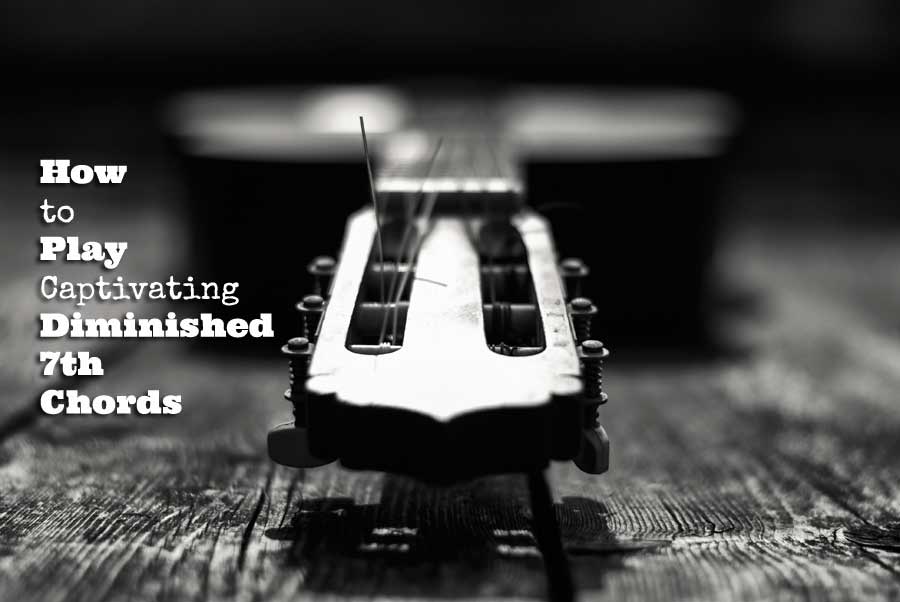May 12, 2019 by Klaus Crow

Diminished chords are considered “dissonant” because of their tonal instability. They create a sense of tension and drama, and have a strong drive toward tonal resolution, meaning that, they want to move to a more final and stable sound (consonance). This is why they are often used in music, they can make a song more captivating, stirring, and charismatic.
The Dim Chords
There are different types of diminished chords: There is the diminished (dim) chord, the half diminished chord (m7♭5) and the diminished 7th chord (dim7). The diminished chord itself is not used very often, the half diminished and diminished 7th chord are more commonly used.
Dim Chord Analysis
Compared to a minor chord (1 – ♭3 – 5), the diminished chord has a flat 5th (♭5), the half diminished chord adds a flatted 7th (♭7) on top of that, and the diminished 7th chord adds a double flatted 7th (♭♭7).
Here are the chord formulas:
Major chord = 1 – 3 – 5
Minor chord = 1 – ♭3 – 5
Diminished chord = 1 -♭3 -♭5
Half diminished chord = 1 -♭3 -♭5 -♭7
Diminished 7th chord = 1 -♭3 -♭5 -♭♭7
Let’s take C as the root for example:
C major = C – E – G
C minor = C – E♭ – G
C dim = C – E♭ – G♭
Cm7♭5 (half dim) = C – E♭ – G♭ – B♭
C dim7 = C – E♭ – G♭ – B♭♭ (or simply “A”)
How to Play Diminished 7th Chords
The diminished 7th chord is made up of minor third intervals. That means all the notes are three semitones (3 frets) away from each other. This specific feature of the chord makes it possible to move the chord 3 frets up the fretboard each time and the chord will remain the same.
We start with a dim7 chord shape played on highest four strings. As you can see below from left to right, we move the diminished chord shape 3 frets up each time. Start the chord shape on the 1st fret, then move up to the 4th fret, the 7th fret and finally the 10th fret. Of course, you can move it up as far as you like.
You can see below that the 4 notes E♭, A, C and G♭ are present in all four chord shapes, only each time they are positioned on different strings. Any of the four notes in the chord can be the root note. So you can name all 4 diminished chord shapes to each of the four notes: Cdim7, E♭dim7, Adim7, and G♭dim7.
The next dim7 chord shape below is played on the middle 4 strings. Again, move the diminished chord shape 3 frets up each time, starting on the 2nd fret, the 5th fret, 8th fret and then on the 11th fret.
The last diminished 7th chord is starting on the low E-string. Bar the D and B string with your first finger.
How to Use Diminished 7th Chords in a Chord progression
It’s great to know how to play diminished 7th chords, but it’s even greater if you know how to apply it to a chord progression. Let’s take a closer look:
The major scale whole-half step formula =
Whole – Whole – Half – Whole – Whole – Whole – Half (2 – 2 – 1 – 2 – 2 – 2 – 1 in frets)
You can insert a diminished 7th chord between every of these whole steps.
Example:
C major scale = C – Dm – Em – F – G – Am – Bdim – C
Now insert a Dim7 Chord between every whole step:
C- C#dim7 – Dm – D#dim7 – Em-F – F#dim7 – G – G#dim7 – Am – A#dim7 – Bdim – C
Here are some chord progressions examples using the chord sequence above:
Chord progression 1: / C / C#dim7 / Dm / G /
Chord progression 2: / C / Em / D#dim7 / Dm G /
Chord progression 3: / C / G / G#dim7 / Am F /
Chord progression 4: / C / Em / F / F#dim7 / C Am / F G /
Of course you can apply this to every key. For example:
G major scale = G – Am – Bm – C – D – Em – F#dim – G
Insert a Dim7 Chord between every whole step:
G- G#dim7 – Am – A#dim7 – Bm-C – C#dim7 – D – D#dim7 – Em – Fdim7 – F#dim – G
Assignments:
– Practice and memorize all three dim7 chord shapes thoroughly.
– Practice playing each chord shape 3 frets up each time.
– Create your own chord progressions using the examples above.
– Use different dim7 chord shapes throughout your chord progressions.
– Incorporate the dim7 chords in your playing and daily practice.
Have fun!
Knowledge is of no value unless you put it into practice ~ Anton Chekhov






Leave a Reply